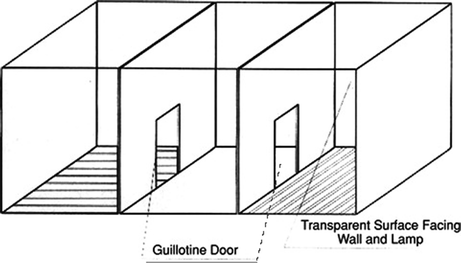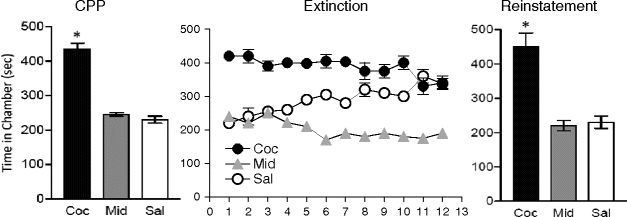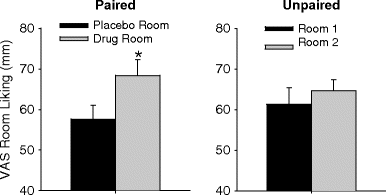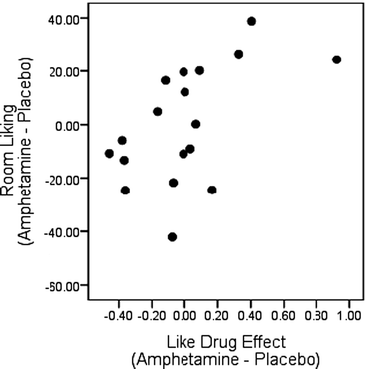Fig. 6.1.
Number of peer-reviewed articles retrieved from PubMed reporting the use of conditioned place preference in the past two decades by year.
2 Key Phases of the Procedure
2.1 Pre-conditioning Test
Most place conditioning studies include a pre-conditioning exposure and test, in which animals are allowed to explore the apparatus before any drug administration to reduce the novelty of the procedure and to assess pre-existing preferences for the two conditioning chambers. Because animals sometimes avoid novel environments, a novel environment may mask a potential CPP for a drug, including a reliably rewarding drug such as cocaine (12). For this reason, animals are usually acclimated to the environment before conditioning. During the pre-conditioning test, the amount of time an animal spends in the two to-be-conditioned chambers is recorded. In most versions of the place conditioning procedure, this initial preference is used to evaluate the rewarding effects of the drug after conditioning, and in some versions of the procedure, this preference is used to assign which chamber is to be associated with drug or vehicle (see below).
2.2 Conditioning
The standard procedure for place conditioning with drugs is to pair one distinct chamber with a drug injection for one session, and pair a second chamber with vehicle in a separate session (see Fig. 6.2). The number of pairings used may vary from one to six, depending on the drug, the dose, and the route of administration (usually intraperitoneal (13)). Although the most common number of pairings is four, CPP has been demonstrated with just a single pairing with morphine (14), heroin (15), or β-endorphin (16). Morphine-induced CPP increases with the number of pairings, from two to four (17). The most common duration of each pairing is 30 min, although this has varied from 4 (18) to 120 min (19). The duration of the pairings is determined in part by the half-life of the drug used for conditioning: drugs with a shorter half-life are typically paired with a chamber for a shorter period (e.g., cocaine 20–30 min) whereas drugs with a longer half-life are paired with a chamber for a longer period (e.g., morphine 30–120 min). Interestingly, Parker and colleagues (19), using a three-choice apparatus to compare preference for morphine, cocaine, and vehicle, demonstrated that the relative CPP for morphine or cocaine-paired chambers depended on the length of the conditioning session; rats showed a stronger preference for the morphine-paired chamber than the cocaine-paired chamber when the pairing durations were 120 min, whereas they preferred the cocaine-paired chamber when the pairing durations were only 15 min. The authors argued that this shift in relative preference was the result of the faster onset of action of cocaine, compared to morphine.


Fig. 6.2.
Example of a place conditioning apparatus. Two distinctly different chambers are separated by a neutral center chamber or tunnel. During conditioning, the animal is confined to one chamber following a drug injection, and the opposite chamber following vehicle injection. At test, the animal is free to explore all three chambers.
Researchers have used two procedures to assign animals to the two to-be-conditioned chambers, the “biased” approach and the “unbiased” approach. With the “biased” technique, animals receive the drug conditioning trials in the least preferred side, as determined by the pre-conditioning test. With the “unbiased” technique, animals are assigned to receive drug or saline in either of the two chambers, based on counterbalanced assignments. There are advantages and disadvantages to each approach. The biased approach takes into account pre-existing preferences for one chamber over the other, which may confound the interpretation of a shift in preference. That is, the effect of the drug may interact with the factors that lead to the initial unconditioned preference, or avoidance, of one of the chambers, in ways that are not related to reward (e.g., fear reduction). On the other hand, with the unbiased procedure, animals spend an equal amount of time in the two chambers before conditioning which, some have argued, may allow a clearer measure of the rewarding properties of a drug (20). Although relatively few studies have directly compared the two techniques, the animals’ initial preferences have been shown to affect the observed CPP with several different drugs. For example, cocaethylene induced a CPP when paired with the initially non-preferred side, but not when paired with the initially preferred side (21). Similar results were obtained with intraperitoneally (IP) administered cocaine (but not intravenous cocaine (12)), subcutaneously administered heroin (22), and for IP administered clonidine (23). [Leu]enkephalin, administered IP, produced a CPP when it was paired with the initially non-preferred chamber, but this drug produced a CPA when paired with the initially preferred chamber (6). The magnitude of CPP for amphetamine also reportedly depends on the baseline preference of the animals (24). These inconsistencies raise some concern about the interpretation of the results of the biased procedure, and indeed, some researchers now recommend the unbiased procedure (3, 4).
Several control conditions have been employed with the place preference procedure to ensure that the observed CPP is related specifically to the process of conditioning. First, some studies have included an explicitly unpaired group that receives the same exposure to the drug and to the chambers, but the drug and environments are not systematically paired. This rules out the possibility that any exposure to the drug, or to the environments, affects place preference. Although this control is not usually considered necessary for most behavioral studies, it is commonly used when examining learning-induced changes in neurochemistry and signaling molecules. For example, in one study, animals that had received explicit pairing between drug and environment exhibited less ERK2 activity in the frontal association cortex than animals that had received the drug in both chambers (25). In another study, explicit drug pairings, but not unpaired drug exposure, induced a significant increase in Fos/GAD67 co-labeling in the prelimbic cortex (26). Another control condition that is sometimes used is to administer vehicle prior to confinement in both chambers. This control is necessary to demonstrate that a CPP is dependent on explicit drug pairings rather than simply exposure to the apparatus and is also necessary when examining signaling molecules associated with drug-related learning (25). Overall, few CPP studies incorporate these control groups, and instead rely on a within-subjects design that allows for comparison of preferences between chambers, rather than between conditioning groups.
2.3 Testing
After drug conditioning trials are completed, animals are tested for preference for the two chambers in the drug-free state. During the preference test, they are given free access to the entire apparatus with all the barriers removed, and the primary outcome measure is the amount of time the animal spends in each of the two chambers. The most typical duration of this test is 15 min, but the times range from 10 to 45 min (13). The duration of the test must be sufficient to allow for a preference to emerge, as animals’ preference for the drug-paired chamber may increase as the test progresses, at least up to 15 min (27). Mueller and Stewart (27) noted that a cocaine-induced CPP was not apparent during the first 3 min of the test, but emerged after 6 min, and then increased in magnitude throughout the 15-min test.
2.4 Extinction
Place preference procedures are sometimes used to study the extinction of drug-associated conditioning. Extinction in Pavlovian conditioning refers to the decline in the frequency or intensity of a conditioned response (CR) when the CS is presented without the UCS. Thus, extinction of a CPP is measured as a decline in the amount of time spent in the chamber previously paired with drug administration, to the point that the animal shows no preference for one chamber over the other, or reverts to its initial, pre-conditioning preference. Some researchers use as a criterion for extinction a significant decrease in time spent in the drug-paired chamber, whereas others examine time spent in the drug-paired chamber among drug-treated versus vehicle-treated animals (28), and yet others use a criterion of spending less than 55% of the total time in the drug-paired chamber on two consecutive days (29).
Two distinct extinction procedures have been used in the CPP paradigm. In one procedure, animals are given repeated CPP tests with access to the entire apparatus in the absence of the drug until the preference is diminished (see Fig. 6.3). In the other procedure, following an initial CPP test, animals receive vehicle in both chambers and are confined to each of the chambers in a similar manner to conditioning. After pairing each chamber with saline across several days, a subsequent CPP test is given to ensure that a CPP no longer is observed. Repeated testing results in a gradual decline in CPP across days, as shown with a cocaine-induced CPP (27, 30–32). Pairing both chambers with the vehicle results in the extinction of a CPP, including that induced by morphine (33), cocaine (27, 32), and ethanol (34). This second procedure does not provide information regarding extinction across days, but rather extinction is evaluated after multiple vehicle trials in a single test.


Fig. 6.3.
Extinction–reinstatement procedure. Mean (± sem) time spent in each of three chambers in which rats (N = 12) received cocaine (Coc; 10 mg/kg, IP), saline (Sal), or no treatment (middle chamber, Mid). Rats were tested for a cocaine-induced CPP, then given extinction training consisting of repeated testing. When a side preference was no longer detectable, rats were given an injection of cocaine and tested for a preference. Cocaine induced a significant reinstatement of the CPP. Adapted from Mueller and Stewart (27). * p < 0.05.
A drug-induced CPP can persist over time, and extinction of the CPP depends upon the number and timing of non-paired exposures to the environment. Drug-induced CPPs remain intact for long periods of time, in the absence of explicit extinction training. For example, a cocaine-induced CPP endured up to 4 weeks (27) and a morphine-induced CPP endured for at least 6 weeks (33) when there were no intervening experiences in the test environment. In other studies, CPP based on morphine conditioning and CPA based on naloxone remained 1 month following the last conditioning trial (17). The intervals between extinction trials also influence the rate of extinction of CPP. Animals that received repeated preference tests with long inter-test intervals of 2 weeks maintained robust preferences across the extinction trials, for both a cocaine-induced (27) and morphine-induced CPPs (33). These results suggest that tests given at sufficiently long intervals serve as reminders to maintain the significance of the drug-related stimuli. Thus, extinction procedures should ensure that extinction sessions are massed (i.e., daily), not spaced (i.e., weekly or longer), in time.
2.5 Reinstatement
Reinstatement refers to the return of a conditioned response after extinction, when an animal is exposed to the unconditioned stimulus. In the CPP paradigm, reinstatement is observed when the drug is administered prior to a standard CPP test (27) and is measured as an increase in time spent in the previously drug-paired chamber (see Fig. 6.3). Other, non-drug stimuli may also lead to reinstatement of a CPP, including exposure to stressors or conditioned stressors (35, 36).
Drug-induced reinstatement of a CPP has been demonstrated with several drugs and in several species. For example, injections of low doses of morphine can reinstate morphine-induced CPP after extinction in both rats (33, 37, 38) and mice (29, 39); heroin reinstates heroin-induced CPP (40), and cocaine reinstates cocaine-induced CPP in rats (27, 36, 41) and mice (42–44), and reinstatement has also been reported with amphetamine (28, 45), nicotine (46), ethanol (34, 47), and MDMA (48). Typically, the dose of drug used to reinstate CPP is lower than (e.g., half) the dose used to establish conditioning. This use of a lower dose is based on the idea that the reinstatement dose provides the animal with a “taste” of the drug while minimizing possible effects of the drug on locomotor and exploratory behavior.
Some studies have also demonstrated drug-induced reinstatement utilizing a drug other than the drug that was used during conditioning. For example, small doses of either cocaine or amphetamine can reinstate a morphine-induced CPP (49, 50), and cocaine-induced CPP can be reinstated by methylphenidate, methamphetamine, morphine, nicotine, and ethanol (42, 51). Finally, morphine and ethanol can also reinstate a nicotine-induced CPP after extinction (46, 52). These cross-drug reinstatement studies are especially valuable to characterize the generalizability of the reinstatement cue. Further, to the extent that reinstatement can be considered to be a model for relapse in humans (53, 54), the ability of other drugs to reinstate CPP may also provide an indication of which drugs pose a risk for relapse among abstinent drug users.
Other studies have shown that acute stress reinstates drug-induced CPP. Acute stress is implicated in relapse to drug use (55, 56), and it effectively reinstates operant responding for self-administered drugs (57). Thus, it is not surprising that stress can induce reinstatement of a CPP after extinction. Several stressors have been shown to reinstate morphine-induced CPP, including intermittent footshock (58), immobilization (59), tail-pinch (59), forced swim (60), conditioned withdrawal in morphine-dependent rats (38), and social defeat (59). Similarly, cocaine-induced CPP is reinstated by intermittent footshock (61), restraint stress (62), forced swim (63), and fear conditioned stimuli (36). Thus, drug-induced CPP can be readily reinstated by any of a number of stressful interventions, suggesting that the memory of the place conditioning remains robust even after an initial period of extinction. A standard rodent place conditioning procedure with extinction and reinstatement test is provided in Table 6.1.
Table 6.1
Rodent place conditioning procedure with extinction and reinstatement test
Pre-test (day 1) | |
1 | Prepare all conditioning boxes with clean floors and drop pans |
2 | Weigh each rat/mouse and place into the center chamber of the box. Record activity |
3 | After the 15-min pre-test session is complete, remove the rat/mouse from the apparatus and return it to its home cage |
4 | Determine whether an unconditioned place preference exists. If so, assign the least preferred chamber as the drug conditioning chamber (biased procedure). If no preference, assign half of rats/mice to one chamber, and half to other in counterbalanced fashion (unbiased procedure). Next, assign half of rats/mice to conditioning (CS+ trials) on odd days, and half to even days |
Conditioning (days 2–9) | |
5 | Twenty-four hours after the pre-test session, initiate the first conditioning session |
6 | Prepare conditioning boxes with the appropriate floors |
7 | Weigh each rat/mouse and immediately inject IP with drug (if CS+ trial) or vehicle (if CS− trial). Place the rat/mouse into the assigned chamber. Record activity during trial (optional) |
8 | After the conditioning trial is complete (i.e., 20 min for cocaine, 45 min for morphine), remove the rat/mouse from the apparatus and return it to its home cage. These trials will occur at 48-h intervals (i.e., on days 2, 4, 6, and 8) |
9 | Twenty-four hours later, prepare the boxes with clean floors |
10 | Weigh each rat/mouse and immediately inject IP with drug (if CS+ trial) or vehicle (if CS− trial). Place the rat/mouse into the appropriate chamber. Record activity during trial (optional) |
11 | After the conditioning trial is complete, remove the rat/mouse from the apparatus and return it to its home cage. These trials will occur at 48-h intervals (i.e., days 3, 5, 7, and 9) |
Note: We recommend a 2-day break between conditioning and the preference test. We have found that this break results in a greater conditioned place preference than if animals are tested the day after conditioning is complete | |
Preference test (day 12) | |
12 | Seventy-two hours after the final conditioning session, prepare each conditioning box with clean floors |
13 | Weigh each rat/mouse and immediately and place into the center of the box. Record test activity |
14 | After the preference test is complete, remove the rat/mouse from the apparatus and return it to its home cage |
Extinction training (days 13–21) | |
15 | On days 13–20, either repeat preference test protocol (repeated testing procedure) or repeat conditioning protocol with vehicle ONLY in both chambers (vehicle pairing procedure) |
Note: Repeated testing procedure may require additional days | |
16 | On day 21, repeat preference test protocol |
Reinstatement test (day 22) | |
17 | Weigh each rat/mouse and immediately inject IP with drug (drug-induced reinstatement) or initiate stressor (stress-induced reinstatement). Place the rat/mouse into the center of the box. Record test activity |
Note: For drug-induced reinstatement, the dose used should be low enough not to impede locomotor behavior (usually half of conditioning dose) | |
18 | After the reinstatement test session is complete (typically 15 min), remove the rat/mouse from the apparatus and return it to its home cage |
3 Physical Aspects of the Testing Environment
The apparatus most commonly used for place conditioning with rodents is a two-chamber or three-chamber (one neutral) box with removable doors to isolate each chamber during conditioning (see Fig. 6.2). The two-chamber apparatus (with or without a neutral chamber) is well suited for studies of place conditioning when only a single drug is being examined, whereas a multiple-chamber apparatus is typically used when researchers compare more than two drugs (e.g., cocaine, morphine, and vehicle (19)). Multiple-chamber units are useful to assess the relative rewarding effects of different drugs. Typically, the apparatus is designed so that the to-be-conditioned chamber dimensions are equal, but the chambers are maximally distinguishable to facilitate the discrimination (e.g., variations in flooring, lighting, and color).
Place conditioning has also been assessed using different procedures, most notably an open field separated into four quadrants (64). The open field version was designed to assess the degree to which animals will maintain contact with drug-paired floor quadrants. During conditioning, drug administration is paired with one type of flooring (e.g., wire mesh) that is inserted into all four quadrants of the open field. The following day, vehicle administration is paired with another type of flooring (e.g., steel bars) that covers all four quadrants of the open field. At test, the animal is placed in the open field, with some quadrants containing the drug-paired flooring and other quadrants containing the vehicle-paired flooring. The number of quadrants containing the drug-paired flooring can be varied from one to three to demonstrate the extent to which an animal will maintain contact with that flooring during a CPP test. Technically, in this case, the animal does not learn an association between a drug stimulus and a place, but rather between a drug stimulus and a floor texture. However, the outcome and interpretation is similar, that animals track stimuli that have been associated with a rewarding drug stimulus.
Natural variations in the physical features of the environment, such as lighting and odors, can influence the outcome of CPP procedures. This is especially true with stimuli for which animals have pre-existing preferences. Because rodents prefer darker chambers over lit chambers, differences in lighting in the two chambers may result in a chamber bias. The animals’ bias toward darker chambers may also be relevant in the selection of colors or wall patterns to differentiate the two chambers. Sometimes researchers use this natural tendency deliberately, when using the “biased” procedure. Animals may also be differentially reactive to different flooring materials. Flooring features are readily discriminated by rodents, and the animals may have pre-existing preferences for certain materials (e.g., rough vs. smooth). To minimize pre-existing preferences while permitting a discrimination, some studies use two types of flooring made of similar material but varying in texture (e.g., stainless steel grid flooring with two vs. four squares per inch). Some studies have used odors to distinguish the two chambers, but these are difficult to control, and may easily be strong enough to be aversive to animals, resulting in a new source of bias. Overall, the physical stimuli associated with the chambers can influence unconditioned preferences, thus inadvertently influence the outcome, or require the investigator to utilize a “biased” procedure to use for conditioning. It should be noted that most commercially available apparatus have a preferred side, requiring the use of the “biased” procedure.
4 CPP in Humans
We have recently demonstrated that CPP also occurs in human volunteers, using oral doses of d-amphetamine as the drug (11). Although there is not as yet a standardized human CPP protocol, the methodological details of the one published study may serve as a guide for future studies. Healthy young adults participated in four 4-h conditioning sessions separated by at least 48 h, in which they received capsules containing placebo or d-amphetamine (20 mg), in alternating order. Half of the participants were assigned to a “paired” group, who received the drug on two sessions in one room and placebo on two sessions in another room, and half were assigned to an “unpaired” group, who received drug and placebo in random order in the two rooms. On the test session, we asked subjects to rate how much they liked each of the two rooms. Subjects in the paired group reported liking the amphetamine-associated room more than the placebo room, whereas the unpaired subjects were indifferent in their room-liking ratings (Fig. 6.4). Most importantly, within the paired group, individuals who reported experiencing the most pleasant effects from the drug on the conditioning sessions also reported greater liking of the drug-associated room (Fig. 6.5). This is consistent with the common, but untestable, assumption that place preference in non-humans is associated with “pleasant” internal effects of the drug. That is, the procedure provided an index of the relationship between place preference and the quality and magnitude of the mood-altering effects of the drug.

 < div class='tao-gold-member'>
< div class='tao-gold-member'>





Fig. 6.4.
Mean (± sem) ratings of liking of the room on a Visual Analogue Scale (VAS) in which subjects received d-amphetamine (20 mg) or placebo (paired group; N=19) or the two rooms (unpaired group; N=12). Subjects in the paired group reported liking the drug-associated room significantly more than the placebo room. Adapted from Childs and de Wit (11). * p = 0.05.

Only gold members can continue reading. Log In or Register to continue
Stay updated, free articles. Join our Telegram channel

Full access? Get Clinical Tree


